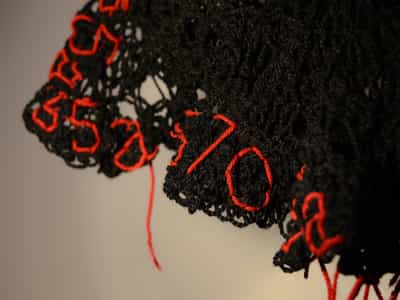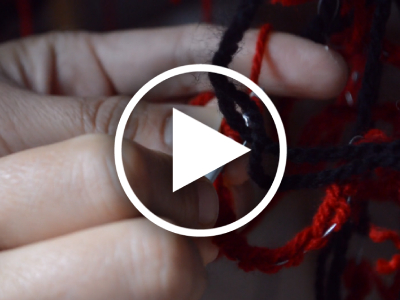A Diplapidated Pheran || تار تار پھیرن
Material: Wool, Thread and Wire.
Method: Metaphorical Crochet, Embroidery.
Facts
Traditional outfit worn by Kashmiri natives male/female "Pheran" Worn during winters, as long loose outfit without side slits made out of wool and with Poot underneath Worn during summers till knee length made out of cotton Embroidered with colourful motives known as "kashikari" for female "Pheran"
Muzna Malik, the artist, has used Metaphorical crochet as a tool for her artistic expression. In her work she has adapted the traditional Kashmiri outfit “Pheran” as a comment on the contemporary conditions of the citizens of the State under the Indian siege. The issue of Kashmir has deep rooted political history steeped in the colonial past of the region. Malik’s work strongly expresses and re-connects her with her Kashmiri ancestral roots. As a gesture of solidarity with Kashmiris, she has taken a traditional protocol of the dress and modified it into a contemporary version — a version she experiences as an expat Kashmiri — to share it with the whole world. According to the Kashmiri population the region has been experiencing everlasting autumn due to their socio/political stipulations thrusted upon them by the world political powers since the last 72 years. Hence, the artist adopted NON - lively colours to create melancholy, desperation and agony of the natives.
Read More
A Diplapidated Pheran
تار تار پھیرن
Material: Wool, Thread and Wire.
Method: Metaphorical Crochet, Embroidery.
Facts
Traditional outfit worn by Kashmiri natives male/female "Pheran" Worn during winters, as long loose outfit without side slits made out of wool and with Poot underneath Worn during summers till knee length made out of cotton Embroidered with colourful motives known as "kashikari" for female "Pheran"
Muzna Malik, the artist, has used Metaphorical crochet as a tool for her artistic expression. In her work she has adapted the traditional Kashmiri outfit “Pheran” as a comment on the contemporary conditions of the citizens of the State under the Indian siege. The issue of Kashmir has deep rooted political history steeped in the colonial past of the region. Malik’s work strongly expresses and re-connects her with her Kashmiri ancestral roots. As a gesture of solidarity with Kashmiris, she has taken a traditional protocol of the dress and modified it into a contemporary version — a version she experiences as an expat Kashmiri — to share it with the whole world. According to the Kashmiri population the region has been experiencing everlasting autumn due to their socio/political stipulations thrusted upon them by the world political powers since the last 72 years. Hence, the artist adopted NON - lively colours to create melancholy, desperation and agony of the natives.
Read More


































